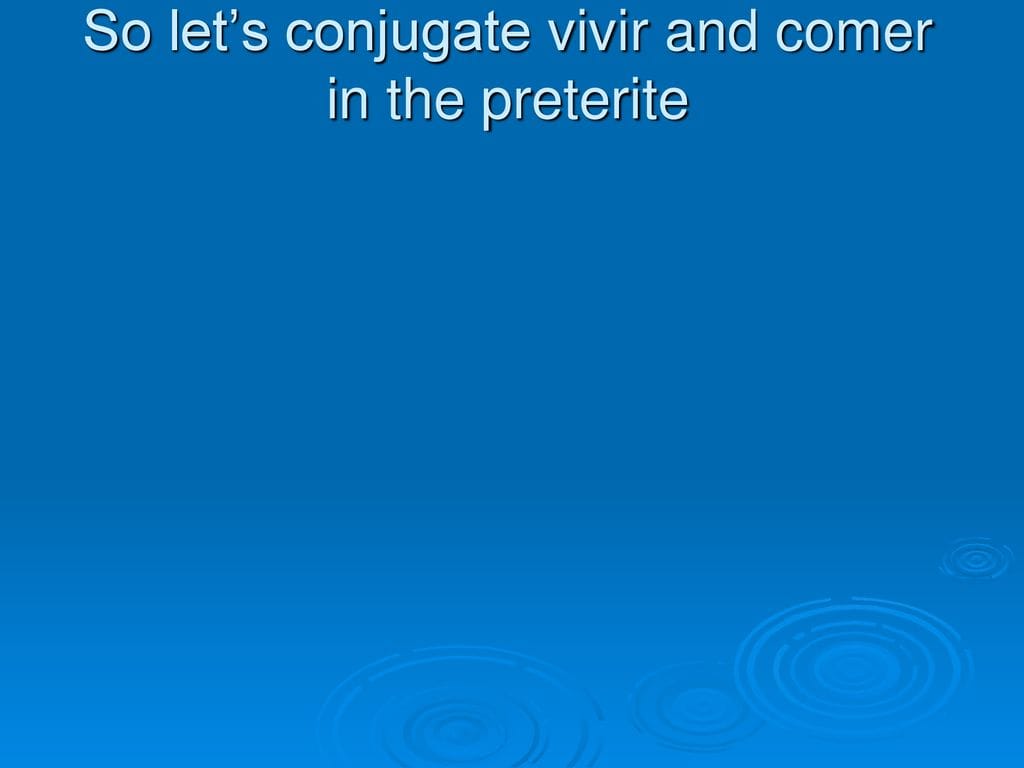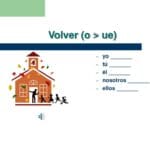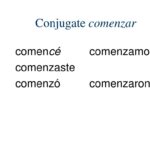This guide provides a comprehensive overview of the preterite tense of the Spanish verb vivir (to live). By the end, you’ll confidently use this tense to discuss past living situations.
Understanding the Preterite of Vivir
The preterite tense describes completed actions in the past. When discussing where you or someone else used to live during a specific period, the preterite of vivir is the tense to use. Think of it like picking a specific photo from an album – a snapshot of a particular time and place you lived.
Conjugating Vivir in the Preterite
Vivir follows regular -ir verb conjugation patterns in the preterite tense. Here’s a handy table for quick reference:
| Pronoun | Conjugation | Translation |
|---|---|---|
| Yo | viví | I lived |
| Tú | viviste | You lived (informal) |
| Él/Ella/Usted | vivió | He/She/You (formal) lived |
| Nosotros | vivimos | We lived |
| Vosotros | vivisteis | You lived (informal Spain) |
| Ellos/Ellas/Ustedes | vivieron | They/You (formal) lived |
When to Use the Preterite of Vivir
Here are some scenarios where the preterite of vivir is appropriate:
Specific Timeframes: “Viví en un pequeño apartamento cerca de la universidad durante cuatro años” (I lived in a small apartment near the university for four years). This pinpoints a distinct, completed period.
One-Time Events: “El año pasado, viví en una casa flotante durante un mes” (Last year, I lived in a houseboat for a month). This describes a single, finished experience.
Sequence of Events: “Primero, viví en Londres, luego viví en París, y finalmente, me mudé a Roma” (First, I lived in London, then I lived in Paris, and finally, I moved to Rome). This narrates a series of completed actions.
Common Mistakes and Tips
Confusing Preterite and Imperfect: The imperfect tense describes habitual or ongoing actions in the past. “Viví en España por dos años” (I lived in Spain for two years – completed) differs from “Vivía en España cuando aprendí a tocar la guitarra” (I was living in Spain when I learned to play guitar – ongoing). Some experts suggest thinking about the preterite as completed events and the imperfect as descriptions or ongoing actions.
Subject-Verb Agreement: Ensure the correct conjugation of vivir matches the subject pronoun.
Practice: Regular practice is key to mastering any tense. Try using the preterite of vivir in conversations, writing, and online exercises.
Context is Key: Pay attention to the timeframe. A completed action calls for the preterite, while an ongoing situation generally requires the imperfect.
Viviamos: Preterite or Imperfect?
This section clarifies the distinction between viviamos and vivimos, both past tense forms of vivir.
Understanding the Difference
Viviamos is the “we” form of the imperfect tense, describing an ongoing or habitual action in the past. It translates to “we used to live” or “we were living.” Vivimos, looking deceptively similar, is the “we” form of the preterite tense, indicating a completed action – “we lived.”
Examples
Imperfect (viviamos): “Cuando éramos niños, viviamos en un pequeño pueblo” (When we were children, we used to live in a small town). This paints a picture of a past habitual state.
Preterite (vivimos): “Vivimos en un hotel cerca de la playa por una semana” (We lived in a hotel near the beach for a week). This describes a completed stay.
Conjugation Table for Vivir
| Tense | Yo | Tú | Él/Ella/Usted | Nosotros | Vosotros | Ellos/Ellas/Ustedes |
|---|---|---|---|---|---|---|
| Imperfect | vivía | vivías | vivía | viviamos | vivíais | vivían |
| Preterite | viví | viviste | vivió | vivimos | vivisteis | vivieron |
Mastering Viviamos
Ongoing or Habitual: Use viviamos for repeated or extended actions in the past.
Completed Actions: Avoid viviamos for actions with a clear beginning and end.
Context Matters: The overall sentence and surrounding circumstances often determine the correct tense.
Some linguists suggest the imperfect can also express what you used to do, emphasizing a past repeated action no longer done in the present. For example, “Antes viviamos en el campo, pero ahora vivimos en la ciudad” (We used to live in the countryside, but now we live in the city). Ongoing research into language acquisition may reveal further insights into these tenses. While these guidelines are helpful, language has nuances. Exceptions and regional variations probably exist. Mastering these tenses enhances communication, allowing for nuanced expression of past events.
Preterite Conjugations: A Deep Dive
This section explores preterite conjugations, essential for discussing completed past actions.
Understanding Conjugations
Conjugations are verb modifications based on the subject performing the action. Just like “I eat” differs from “she eats,” Spanish verbs change endings based on the pronoun (I, you, he/she/it, we, they, and formal “you”). Regular verbs follow predictable preterite conjugation patterns, grouped by -ar, -er, and -ir endings.
Example: Hablar (to Talk)
Here’s the preterite conjugation of hablar, an -ar verb:
| Pronoun | -AR (Hablar – to talk) | -ER (Comer – to eat) | -IR (Vivir – to live) |
|---|---|---|---|
| Yo | hablé (I talked) | comí (I ate) | viví (I lived) |
| Tú | hablaste (You talked) | comiste (You ate) | viviste (You lived) |
| Él/Ella/Usted | habló (He/She/You talked) | comió (He/She/You ate) | vivió (He/She/You lived) |
| Nosotros/Nosotras | hablamos (We talked) | comimos (We ate) | vivimos (We lived) |
| Vosotros/Vosotras | hablasteis (You all talked – Spain) | comisteis (You all ate – Spain) | vivisteis (You all lived – Spain) |
| Ellos/Ellas/Ustedes | hablaron (They/You all talked) | comieron (They/You all ate) | vivieron (They/You all lived) |
Memorization or immersive practice might be more effective learning strategies, depending on different expert opinions. A key challenge is distinguishing the preterite from the imperfect. The preterite denotes completed actions, while the imperfect describes ongoing or habitual past actions. Practice using the preterite in simple sentences to build fluency. Irregular verbs add complexity, but this guide provides a solid foundation.
What Tense is Vives?
This section clarifies the tense of vives within the context of the verb vivir.
Understanding Vives
Vives is the second-person singular (informal “you”) form of vivir in the present indicative tense. It simply means “you live.” For example, “¿Dónde vives?” translates to “Where do you live?”
Vives vs. Viviste
Vives denotes present action, whereas viviste, the preterite form, means “you lived” – a completed past action. For instance, “Viviste en Madrid por dos años” means “You lived in Madrid for two years” (completed). Vives refers to the present, viviste to the past.
Conjugation Table: Present and Preterite of Vivir
| Tense | Spanish Verb | English Meaning | Example |
|---|---|---|---|
| Present | vives | You live | ¿Dónde vives? |
| Preterite | viviste | You lived | Viviste en Madrid por dos años. |
Expanding on Vivir: Other Tenses
Beyond present and preterite, vivir has other tense forms.
- Future: Viviré, vivirás, etc. – expresses future living situations.
- Imperfect: Vivía, vivías, etc. – describes ongoing or habitual past living situations.
- Conditional: Viviría, vivirías, etc. – expresses hypothetical living situations.
Providing examples of each tense further illustrates usage: “Tú vives en España” (You live in Spain), “Yo viví en México por dos años” (I lived in Mexico for two years). Nuances exist, potentially leading to subtle meaning variations depending on context. For example, vives might emphasize the ongoing nature of living (“you are living”). This adds layers to language learning.
Learn more about the verb ‘préférer’ by exploring preferer conjugation and learning how it’s used in French.
Excited to learn more about re34’s lore and characters? Explore the entire section dedicated to this topic.
- Guatemala vs. Costa Rica: Plan Your Trip Smartly - April 16, 2025
- Master Types of Pumps: Ultimate Guide to Selection - April 16, 2025
- Unlock Types of Makeup Secrets: Master Any Look Now - April 16, 2025

















2 thoughts on “Mastering the Preterite of Vivir: A Comprehensive Guide”
Comments are closed.